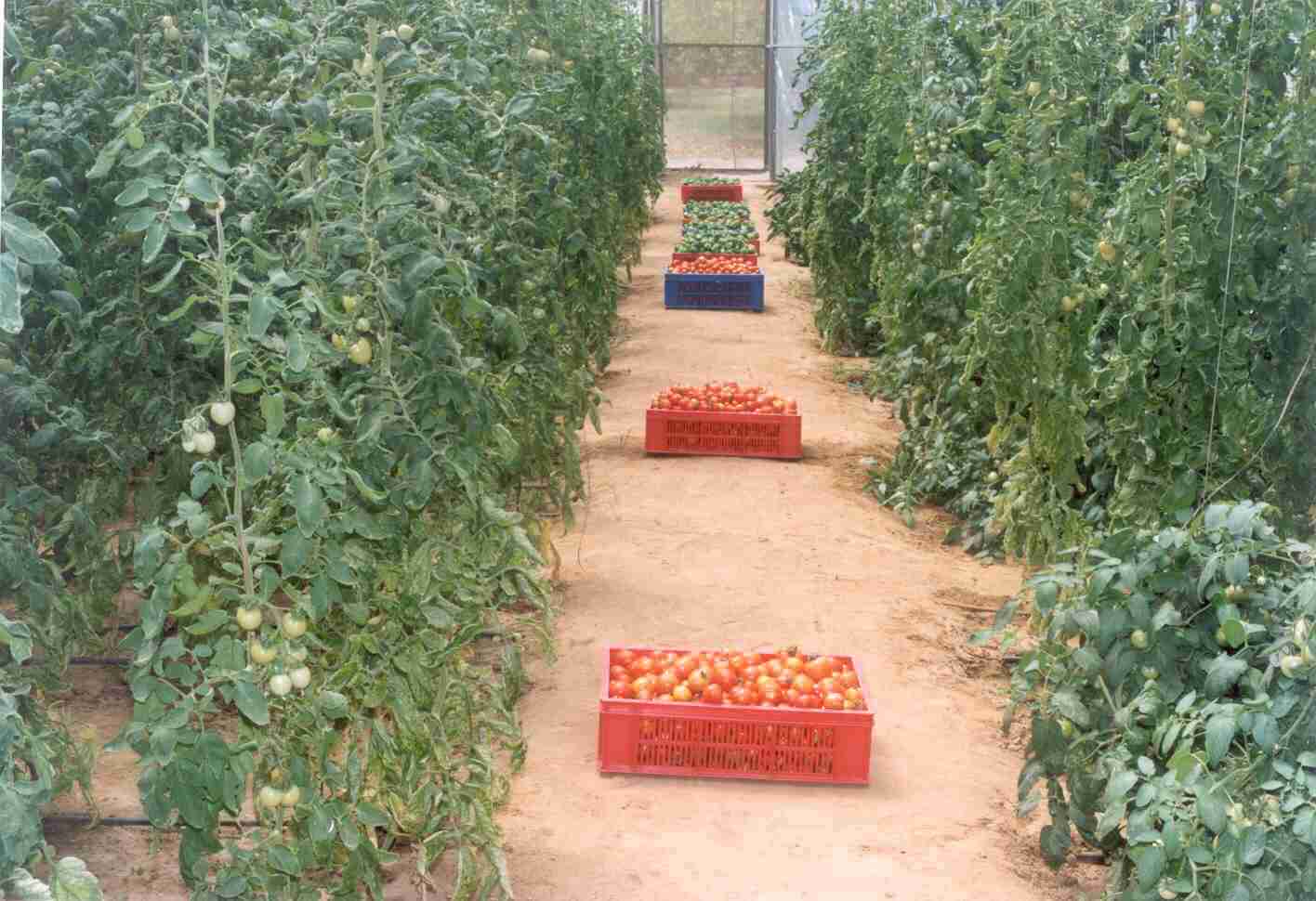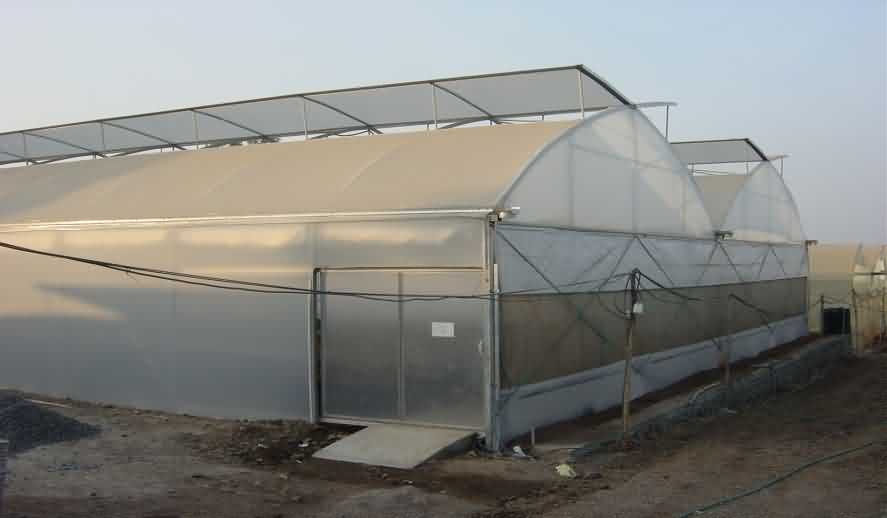ग्रीनहाउस के तहत टमाटर की उत्पादन प्रौद्योगिकी
 Greenhouse cultivation of vegetables offers distinct advantages of quality, productivity and favourable market prices to the growers.
Greenhouse cultivation of vegetables offers distinct advantages of quality, productivity and favourable market prices to the growers.
Vegetable growers can substantially increase their income by greenhouse cultivation of vegetables in off season as the vegetables produced in the normal season generally do not fetch good returns due to large availability of these vegetables in the market.
Greenhouse technology is popular in countries viz., U.S, Canada and Europe. It allows precision farming and overcomes limitations of space and disadvantages of climate change.
Production of vegetables under protected conditions is increasing worldwide. In these systems various factors of the environment such as air, temperature, humidity, atmospheric gas composition etc., are controlled.
Protected cultivation in the form of greenhouses, net houses, low tunnels, mulches etc., offers several advantages to grow crops of high quality and yields, thus using the land and other resources more efficiently.
Selection of vegetables
The choice of vegetable crop to be raised in greenhouse is made on the basis of the size of the structure, the economics of the crop production and income generated (profit). It may be possible to raise any crop at any time in a high cost green house, selection of crops is more critical in case of ordinary low cost green house.
The high value vegetable crops viz., tomato, capsicum, brinjal and chilli have been more popular for cultivation in greenhouse. The labour and other input requirement per unit area in greenhouse is more than that of open field conditions.
There is always a large and sustained demand of fresh vegetables round the year in big cities. Among vegetables tomato is the first crop grown in greenhouses worldwide. It is relatively easy to grow under protected conditions.
Selection of tomato cultivars
Selection of the most suitable cultivar is a prerequisite for successful tomato cultivation in greenhouse. Important considerations are size, shape and colour (red or pink).
Important characteristics related to cultivars include high yields, freedom from cracking, disease resistance, high percentage of number of fruits and freedom from green shoulder, good shelf life and TSS.
Some of indeterminate elite varieties/ hybrids which have performed exceedingly under low cost greenhouses are DARL – 303, HT - 6 Sun – 7611, NS – 1237, Naveen, NS – 4130, Abiman, COTH – 1, NDT – 5, NDT – 120, Pusa Divya, Meenakshi, and Lakshmi.
Climate requirements for tomato
Temperature and light intensity affect fruit set, pigmentation and nutritive value of the fruits. Critical factor in setting fruits of the tomato is the night temperature, the optimum range being 16°C to 22°C. Fruits fail to set at 12°C or below.
Fruit set is also reduced markedly when average maximum day temperature goes above 32°C and average minimum night temperature goes above 22°C. At temperatures below 10°C, red and yellow colours do not develop.
The ideal range for development of both red and yellow colours is 18-250C. Under greenhouse conditions tomato crop can be grown for long duration (10-12 months) by cooling the greenhouses during summer months (April to July) and by heating the greenhouses during peak winter (December and January) months.
Preparation of soil, nursery raising and planting
In northern plains the tomato crop is planted from first August to second week of September under greenhouse conditions. August or September planted crop is continued upto June or July under climate controlled greenhouse conditions.
If the greenhouse is naturally ventilated then the crop can be grown up to April or May months. Nursery for greenhouse tomato is raised under protected structure mostly in soil less media in plastic trays to produce disease free and virus free seedlings.
The seedlings are ready for transplanting within 28-30 days under soil-less media. Healthy seedlings are transplanted at a planting distance of 60 x 45 cm mostly under drip irrigation system for efficient use of water and fertilizers.
Transplanting is mostly done in the early morning or late evening time for better establishment of the seedlings.
Training, pruning and trellising
Greenhouse grown tomatoes needs regular trellising, training and pruning of plants. Single stem (main) should be retained by removing all side shoots or suckers that develop between leaf petioles and the stems.
Usually in early stage shoots are removed by snapping them off, not cutting them by knife, blade or scissors, as diseases mainly the virus (T.M.V.) can be transmitted from one plant to other.
Plants are supported by plastic or binder twine, loosely anchored on the base of plants with the help of plastic clips or directly by non-slip loop and to overhead support wires (11 to 12 gauge) running to the length of the row of the bed.
Overhead wires are fixed normally 8 to 9 feet above the surface of the bed and are anchored firmly to the support structure. Twine should be wrapped clockwise around the vine as it develops with one complete swirl every three leaves.
The vine should be supported by the twine under the leaves, not the stems of the flower truss or fruit clusters. Twine is not wrapped around the growing tip otherwise the tip may break. When the plants reached overhead supporting wires, untie the twine (or take down the twine) from the twine roll after unlocking it to take down the vines at least 2 to 3 feet in every 15-20 days gap.
Vines with twines are moved in one direction with twine roll in one row on the overhead wires and in opposite direction in the adjacent row. The plants must be pruned and trellised on regular basis for 10-11 months life cycle of the tomato crop in greenhouse and as a result plants are 30-35 feet longer in their 10-11 months life cycle of cultivation.
Clearly, the greenhouse will not be able to accommodate the plants vertically. As fruits mature on the lower parts of the vines, pinch off older leaves below the fruits. This will, provide air circulation, which helps to reduce the incidence of the diseases and opens vines up for spraying and harvesting. Removal of excess fruits will also result in larger tomatoes at harvest that can fetch good price.
Pollination requirement in green house
Although tomato is highly self pollinated crop but aided pollination of flowers is generally needed in the green house grown tomatoes due to limited air movement and high humidity. In several countries bumble bees are being used as a pollinator for the green house tomato crops. Bumble bees are the perfect pollinators, even under environmental stress condition (i.e. under low and high temperature conditions).
But in several countries an electric or battery –powered vibrators are being used to vibrate flowers cluster above the area where they originate from the stem. The vibration will release sufficient pollens necessary for pollination. This practice is done twice a day (10:00 AM to 11.00 AM and 2.0-3.0 PM). Flowers are vibrated or shaken every day. Air from a mistflower also has been found effective in pollinating tomatoes inside the protected structures.
If tobacco mosaic virus (T.M.V) has been a problem the vibrator should be wiped after each use with a clean cloth.
Fertigation in Tomato in greenhouse
Application of 350: 350: 350 kg NPK/ha in the form of water soluble fertilizers through fertigation at weekly intervals is recommended for getting maximum productivity and best quality of tomato under cost effective greenhouse.
Cooling and heating of the greenhouses
Most of the climate controlled greenhouses are having evaporative cooling system. In northern plains of our country cooling is done from September to October and from April to June months. Evaporative cooling system is quite effective when the relative humidity in the atmosphere is below 40%.
Heating of the greenhouses can be done from 15th of December to end of January, to increase the temperature of the greenhouse during nights, so that the temperature can not fall below 140 C. Heating and cooling of the greenhouses are required during growing of tomato for a period of 10-12 months.
Harvesting and post harvest handling of fruits
Harvesting of tomato fruits is a continual process throughout the growing cycle. Generally most of the varieties are ready for first picking 75 to 85 days after transplanting. Big size tomato (slicing tomato) fruits are harvested singly with attached calyx, and are graded and packed according to grades.
Under greenhouse conditions tomato can yield 100- tonnes/ha. During the summer months harvesting should be done in the early morning or late evening to avoid post harvest losses.
Tomato Plant protection in greenhouse
Mostly greenhouses are designed to minimize or eliminate insects and diseases problems so that plants can be grown pesticide free under many conditions. Generally all four sides of greenhouses are covered with insect proof nylon net of 40 to 50 mesh size to prevent insects, including white flies, thrips, aphids etc.
Preventing insects from entering the protected structures is the best way of controlling virus and insect problems. However, if required, one or two sprays of insecticides can be done on need base. One spray of metasystox @ 1.5 ml/litre of water is done 10 days after transplanting of the crop.
If there is severe problem of mites, we can spray dicofol @ 2.0 ml/litre of water. Sometimes white flies or thrips entered in greenhouses, yellow and blue trappers are used for trapping of such insects.
For control of root knot nematodes and other soil borne pathogens, soil sterilization is most effective and it is done by applying the formaldehyde (37%), one month before transplanting of the crop.
Sometimes if some plants are infested with T.M.V, such plants are to be removed immediately to avoid further spread of virus inside the greenhouse.
Authors:
Dr.S. Ramesh Kumar
Assistant Professor, Department of Horticulture,
Vanavarayar Institute of Agriculture, Manakkadavu, Pollachi, TNAU, Tamil Nadu, India
Email:

